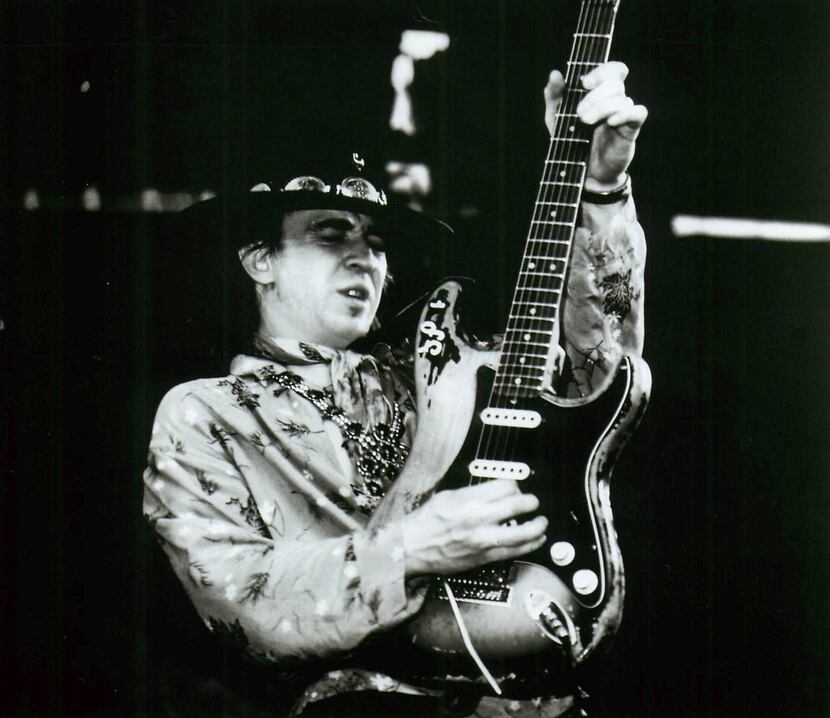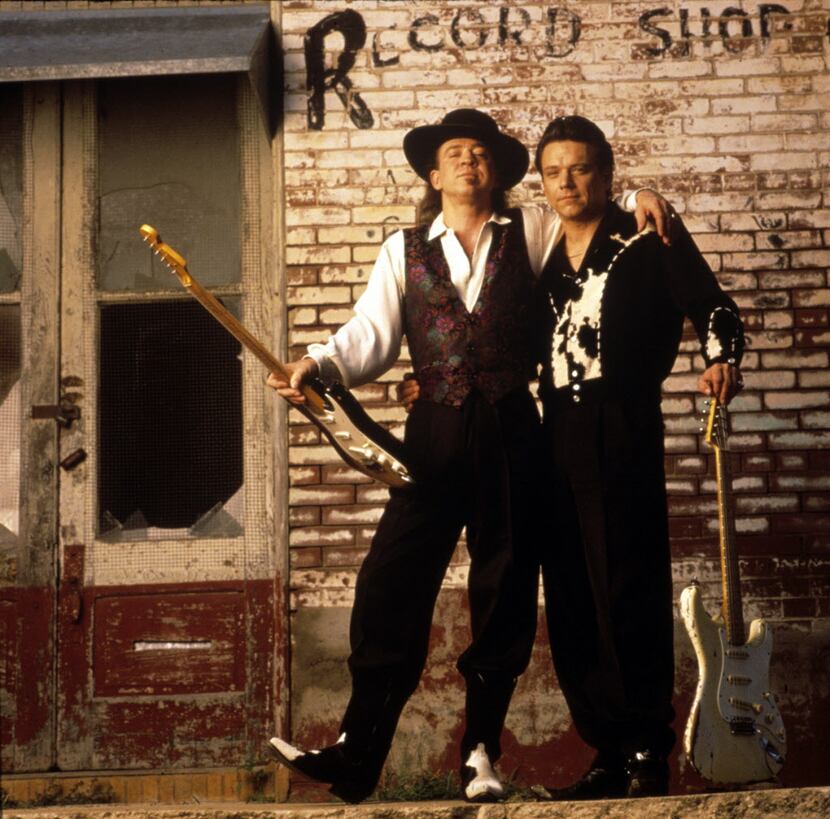Editor's note: This profile of Stevie Ray Vaughan, by Diane Jennings, was published in The Dallas Morning News on June 6, 1990, just a few months before Vaughan's death. Read Jennings' recollections of that interview here.
Stevie Ray Vaughan is sipping club soda at Good Eats Cafe and talking about what first attracted him to the blues, when a waiter interrupts.
"I hate to bother you, but can I get you to sign this?' he asks, nervously pushing a piece of paper at the renowned guitarist. "I really appreciate it.'
As Stevie scribbles his name, the waiter apologizes profusely. "I'm sorry -- I'm a real big fan of yours.
"I've seen this guy in concert about 20 times . . . ,' he explains to a listener. "My girlfriend really likes him too, and we make love to (his music) all the time. It has a real sensual quality to it, sort of real powerful.' "
Across the table Stevie, who is home for a few days between concerts, slowly turns red with embarrassment.
The waiter leaves, only to be followed by another employee armed with a felt-tip pen. He wants Stevie to sign the restaurant mural, which includes an almost life-sized picture of the musician. A few minutes later, the waiter returns, camera in hand, for a quick picture.
"I have to remember that these people just like what we do," Stevie says as the flurry of attention subsides. For years he could retain his privacy by leaving his trademark black hat at home, but after several gold records and two Grammy Awards, including one this year, "that doesn't work anymore."
He is grateful for the attention, Stevie says, and he understands it, because he used to do the same thing. The younger brother of Jimmie Vaughan of The Fabulous Thunderbirds fame became starstruck at an early age. When he was 13, he hung around with the same awestruck look on his face at the Losers Club, to ask blues great B.B. King for his autograph.
Next week Stevie and Mr. King meet in Dallas again. This time however they'll be headlining the Benson & Hedges Blues festival.
Stevie is pleased to be sharing the stage with a childhood hero, but not surprised. "I don't mean this to sound big-headed or anything," he says, "but I always knew I was going to be doing something with the talents that I was given. I always knew that."

'I was high everywhere'
The sight of a clear-eyed, lucid Stevie Ray Vaughan sitting in a restaurant at midday is inspiring not just to music fans but to anti-drug crusaders as well. Five years ago when Stevie did an in-depth interview, he had trouble focusing on questions, rarely answered with more than a syllable or two, and frequently excused himself, only to return considerably more animated than when he left.
"I was high everywhere," he says now.
Stevie had been using drugs since childhood. By his early 30s he was drinking himself to sleep and snorting something to wake up, he says. He was "throwing up, and falling down, and running into walls, and thinking people were after me," he says. "And running from other people, people that cared about me."
"It was getting real destructive, real sick," says bass player and running buddy Tommy Shannon. "It was (an) unnatural, unreal, untruthful way of living. Just a dead-end street. If we hadn't quit we'd either end up in a hospital or dead."
Stevie's music didn't appear to suffer much, but "it got to where I didn't want to do anything but just stay in my room and go completely berserk," he says. When he did play, he was thinking about "getting high."
Stevie sobered up more than 3 1/2 years ago, and he talks about his experience with the gratitude of a survivor.
"I'm a lot happier now than I've ever been," he says. Life hasn't gotten easier, he notes, but he's better able to cope.
When he performs, Stevie talks briefly about staying clean, trying to negate his former party-hearty image. "I had the attitude that if I was higher than you, I was cooler than you, and you didn't know what you were missing," he explains. "That's what I thought for a long time. And I learned that, you know -- I didn't come up with the idea. That was part of the '60s code, part of rock 'n' roll myth. And I believed it, so I passed it on for a lot of years."
Today Stevie sends the message that "you can still be cool (and) you can still be clean and sober," says Michelle Suggs, a clinical social worker at Yale Psychiatric Institute. He corresponds with some of her clients, and occasionally meets with them after concerts.
Stevie says he worries sometimes that his speeches are simply attempts to pat himself on the back, but after almost every show fans thank him for helping them break their addiction.
"If even one person gets something out of it, great," he says. "It's worth doing it."

Picking up the guitar ... and not letting go
Stevie picked up his first guitar when he was 7 years old because he'd seen his big brother, Jimmie, do it. As a child growing up in Oak Cliff, he idolized Jimmie, who is 3 1/2 years older.
Other boys in the neighborhood played football, but when Jimmie broke his collarbone a friend gave him a guitar and said, "Play this and it won't hurt you."
Stevie too tried to play the sport, but "I was so good at football that I never got a number," he says wryly. "I didn't even have no zeroes."
Like most older brothers, Jimmie didn't pay much attention to his younger sibling. "It was my guitar and my records," Jimmie says. "When I left, I would say, "Don't touch my guitar because I'm going to get you. Leave my guitar alone." And of course, when I would leave, he would go straight in there and play with my guitar and try to learn what I had been playing."
Once Stevie picked up the instrument, he rarely let go. "After he started playing, he just never quit," says Stevie's mother, Martha. "I've gone in their rooms many a time and they were asleep with their guitars in their arms."
At first Stevie listened to rock 'n' roll, tuning his radio late at night to faraway stations and listening to musicians such as Stevie Wonder. His schoolmates didn't share his tastes, however. "They would start calling me "Stevie Wonder' as they beat me up," Stevie says. "You know "Little Stevie." Stevie thanked them -- not for pounding him, but "for calling me Stevie Wonder."
His musical horizons expanded when his brother brought home records by blues artists such as Buddy Guy, Lightnin' Hopkins and Muddy Waters. The words and music touched Stevie, lighting a passion for playing that still burns.
"You could as easily pull that guitar from his hands, or get him to do that, as easily as you could get him to cut his own arms off . . . It's just his life," says drummer Chris Layton.
Though Stevie was dedicated to music, the family concentrated on Jimmie's talent. The boys' father was an asbestos worker, but in his spare time, he managed his older son's fledgling career. Stevie and his mother tagged along when Jimmie's band appeared at local clubs, and occasionally Stevie would sit in. But it was Jimmie who quickly became known as one of the hottest guitarists in Texas, a state known for great players.
The boys' uncle, Joe Cook, remembers driving to a family reunion one day with Stevie strum- ming his guitar in the back seat. "He'd say, "Hey, Uncle Joe, listen to this . . . ' Mr. Cook recalls. "I'd say, "you keep that up, you'll be as good as your brother.' "
Years later, Mr. Cook laughs at the memory. "If I'd had any idea, that that boy would have been the guitar player he'd be today," he says, "I would have stopped the car and let him play awhile."
Moving to Austin: 'I fit in just right'
Stevie Ray Vaughan is a guitar player's guitar player. His name may not be well-known to pop radio listeners, but he is widely regarded in the music business as a master of his craft. Rolling Stone magazine recently dubbed him a "guitar guru." Guitar World called him "the most popular, most widely exposed blues celebrity."
The first person to notice Stevie was Doyle Bramhall, the drummer in one of Jimmie's bands. He heard Stevie playing one day when he visited the Vaughan home, and "sat down and listened to me for a minute," Stevie says. "I'll never forget that."
"He had a feel, even back then," Mr. Bramhall remembers.
When he was 13, Stevie began playing in Dallas clubs. Tommy Shannon remembers the first time he heard Stevie play in 1970. "I was walking down the sidewalk and I heard this guitar player that I couldn't believe," he says. "I thought, God, who was that? I went inside and there was this little kid."
For three years Stevie played at night and attended school during the day. But "I couldn't play until 6 in the morning and go to school," he says. A few months into his senior year at Kimball High, he followed his brother's lead and quit school.
Dropping out didn't bother him then, Stevie says, but now "I wish I had a diploma. I'm not sure what it really is, I just wish I had a diploma."
Jimmie had left home for Austin, the heart of the Texas music scene, several years earlier. In January 1972, Stevie followed suit. For years he bounced from band to band, and club to club, sleeping on floors or pool tables during the day, playing guitar at night.
"It was a crazy time in a crazy place and it was just real appealing to me," Stevie says. "I was kind of crazy. I fit in just right."
As the bands made the Texas circuit, Stevie's reputation spread. Fans and critics loved his own brand of rocking Texas roadhouse blues -- lauding the sounds he pulled from his guitar as well as the flamboyant way he delivered them.
In 1981 Stevie started a new band called Double Trouble. A few months later, a mutual friend showed rock star Mick Jagger a videotape of the band, and soon Double Trouble was headed to New York to play for The Rolling Stones at a private party.
That, says Stevie, "was worth a call to my mother."
The 35-minute party set stretched to almost three hours, but the band didn't get the recording contract they wanted. Several weeks later, however, record producer Jerry Wexler heard Double Trouble play, and persuaded the musical director of the prestigious Montreux Jazz Festival to hire them. No one without an album had performed at the Swiss festival before, but the band's appearance caught the attention of such stars as David Bowie and Jackson Browne, as well as legendary record producer John Hammond.
The late Mr. Hammond became a fan of Stevie's, helping him find a record label, and producing his first album, Double Trouble's Texas Flood. Stevie had participated in recording sessions since the early '70s, but Texas Flood's release in 1983 was his first album. The record got off to a slow start and was expected to flop, Stevie says, but since then has sold almost 1 million copies.
By the mid-80s his career was "working out fine," Stevie says. Personally, however, he was "steadily turning into a shell."

'I nearly died'
When Stevie sees a picture of himself, he doesn't particularly like what stares back. His image has evolved through the years, to include the tattoo that decorates his chest, the earring that dangles from one lobe, the signature black hat that hides his thinning hair, and a flamboyant wardrobe. But no matter what he wears, his outward appearance never fits his inner image, because Stevie has often wished he had been born black.
The blues are a predominantly black art form, and being white can be a handicap, Stevie says. Sometimes he feels out of place.
"But I'm trying," he says, "to learn to be who I am."
That hasn't been easy. As a child, he used to play his guitar, drink and think "I was going to be it," he says. But as his reputation grew, he became more and more confused about what it was.
He began drinking alcohol at age 6, sneaking sips from his father's glass. Through the years he worked his way up to "whatever was around -- different psychedelics, pot, speed, diet pills, pain pills, sniffing glue, drinking. Then later I found out about cocaine."
As Stevie and Double Trouble became better known, he began using stronger drugs, until it was "a hassle to do anything except go in my room and get loaded."
He tried to quit twice, but each time started using again. "When I quit for three months, I decided that I was such a jerk sober I might as well drink and have fun," he says.
Then in 1986, "I nearly died," he remembers, "and it got my attention."
Stevie collapsed during an engagement in London. He was throwing up copious amounts of blood and suffering from deep depression, and felt he was losing his mind. When a doctor explained his condition, Stevie checked into a hospital. Deciding he would rather live sober than die high, he called his widowed mother and his girlfriend, who both joined him immediately. Then he boarded a plane for a treatment center in Georgia.
Stevie expected the treatment center "to be kind of like Club Med," he says. But he quickly found out "you have to start digging around and find out what's going on inside."
This time, because he was no longer "white knuckling" it alone, the program worked. He left the center after only four weeks, and hit the road again. Today he continues to work with a program daily.
To make recovery easier, Stevie also took several practical steps. His mother and friends went through the family counseling program, and Stevie keeps in close touch with Tommy Shannon, who underwent treatment himself. "We've helped each other out," Mr. Shannon says.
In addition, Stevie left Austin for Dallas. An early marriage was ending, and though he had once sworn never to return to Dallas, Stevie needed to "change my playground." He likes being close to his mother, friends note, and his longtime girlfriend, a model, lives here. He's considering buying a house, Stevie says, but today he rents one on the edge of Highland Park. He recently took a place in New York as well, but wherever he travels, Stevie still calls Texas home.
"I go other places and they're real neat for a few days or a month," he says, "and then I miss it so bad it's like I can't wait to get back."
When he is on the road, Stevie avoids clubs and the temptation to drink. Instead, tour manager Skip Rickert, who was hired to help Stevie "make a clean break from the lifestyle he had been involved in," says the band occasionally goes bowling.
Some might call the quiet lifestyle boring, Stevie acknowledges, but he says he appreciates the joys of daily life, such as getting to know people.
"I'm also reaching back and finding little things about being a kid that are real neat, that I never took the time to do," he says. For example, he's begun reading children's books that he missed, "because I was too busy growing up and being a guitar player, to be a kid."
Today, "I'm not well," Stevie emphasizes. But "I do the things that give me a chance."
Less wild and crazy
When Stevie Ray Vaughan strolls on stage and gazes out over the audience, he loves the feeling that nobody there knows what's about to hit them.
If it's a good night and everything clicks, "your toes curl up, and you get chillbumps all over the place," Stevie says. "That's when you know you're doing it. And when it's not hard, when it's effortless."
It doesn't happen often, Stevie says, "but that's what I play for."
Despite years of touring, Stevie's "incredible passion' for music burns just as it did in childhood, says Doyle Bramhall. "He's one of the only players I know that, if he's not playing on stage, he picks his guitar up all the time. He just loves what he's doing."
Though his Dallas appearance next Sunday is part of a multicity tour, Stevie is hitting the road less often these days and trying to enjoy it more. He's also doing something he's wanted to do for a long time: record with his brother. Though the two have played together before, it has been with one of their bands. This time it's just the two of them.
"It's very Vaughan," says Jimmie. "We're just doing it the way we hear it . . . If you like what we do, you'll like it."
Of the two brothers, Stevie has become better known. He says that's simply because he has a flashier style, however, and he still considers Jimmie the better guitarist.
"He plays about this much of what he knows," Stevie says admiringly, holding his thumb and forefinger barely apart. "And I play as much as I can think of at the time."
Stevie says his music is better now than it was during his wild and crazy days because, "there's more music in it. I think it's more alive and makes more sense."
He's having fun with it again, he says, even though he doubts he'll ever be satisfied. Still, "I'm the best I can be in these boots."

